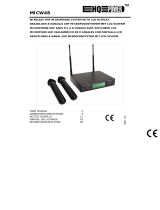PROMIX22U_v3 HQPOWER
14
4. Les ÉGALISEURS
Tous les canaux d’entrée mono sont munis d’une égalisation 3 bandes. Les potentiomètres supérieur
(HIGH) et inférieur (LOW) on tune fréquence de 12kHz et de 80Hz respectivement. Le potentiomètre des
moyens a une réponse en crête, avec un Q fixé à 2 octaves et une fréquence de 2.5kHz. Les trois bandes
ont une intensité d’augmentation et de diminution jusqu’à 15dB avec un déclic central pour « off ».
5. Réglage PAN
Le PAN positionne le signal de sortie du canal dans le champ stéréo du mixage général. Ses spécifications
éliminent les décalages de niveau de volume, qu’il soit situé sur un côté, au centre ou entre-deux.
6. LED de SURCHARGE
La LED de SURCHARGE (PEAK) s’illumine dès que le canal atteint la surcharge. Il détecte le niveau de
crête après l’EQ et la LED s’illumine à partir de 3dB avant la saturation pour avertir que le signal approche
la surcharge. Veillez à ce que la LED ne s’illumine pas excepté de manière intermittente pendant une prise
ou le mixage. Si la LED s’illumine régulièrement, diminuez le gain d’entrée avec le potentiomètre TRIM (3).
7. Réglage LEVEL
Le potentiomètre du GAIN détermine le niveau du signal de sortie vers le bus de mixage maître. La table
de mixage n’est pas munie de la fonction PFL. Pour régler le gain de chaque canal, tournez le gain de tous
les autres canaux complètement vers la gauche et placez le canal et le MASTER MIX (16) à gain unitaire
(0dB). L’échelle à LED (15) doit afficher aux alentours de 0dB.
b. Entrée stéréo
7. Réglage LEVEL
Le potentiomètre du GAIN détermine le niveau du signal de sortie vers le bus de
mixage maître. La table de mixage n’est pas munie de la fonction PFL. Pour régler le
gain de chaque canal, tournez le gain de tous les autres canaux complètement vers
la gauche et placez le canal et le MASTER MIX (16) à gain unitaire (0dB). L’échelle à
LED (15) doit afficher aux alentours de 0dB.
8. Entrée LINE
Chaque canal stéréo est muni de deux entrées à niveau en ligne symétriques en
forme de prise TRS ¼” pour les canaux de gauche et de droite (la pointe = positif (+),
la bague = négatif (-), le manche = masse). Si vous n’utilisez que la
connexion marquée « L » (left ou gauche), le canal opère en mono. Les canaux
stéréo ont été conçus pour accepter des signaux à niveau en ligne typiques. Les
signaux d’entrée sont soit symétriques soit asymétriques.
9. Réglage BAL
Cette fonction est identique aux réglages PAN (6) des canaux mono si vous
connecter un signal mono à l’entrée L (MONO). Cependant, si un canal fonctionne
en stéréo, ce réglage fonctionne de manière identique au réglage BALANCE,
déterminant la balance relative entre les signaux de gauche et de droite routés vers
les bus MASTER de gauche et de droite. Exemple : avec le réglage BALANCE
complètement vers la droite vous routerez uniquement la partie de droite d’un signal
stéréo vers le MASTER MIX.
c. Master
10. Sortie STEREO
Utilisez ces sorties pour y brancher un amplificateur externe si de la puissance
supplémentaire est nécessaire, p.ex. pour alimenter un système de sono de façade.
Les sorties stéréo sont des sorties ¼” asymétriques, câblées comme suit : la pointe
= positif (+), la manche = masse.
11. Sortie PHONES
Cette sortie alimente le casque d’écoute et est câblée comme suit : la
pointe = signal de gauche, la bague = signal de droite, la manche =
masse.






























